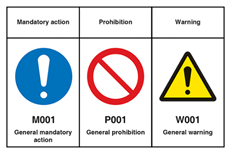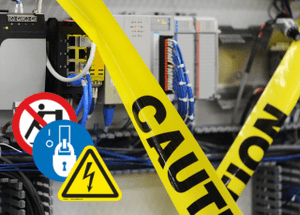Understanding the Latest ISO 7010 Update

ISO 7010: What Is It?
Product manufacturers and safety personnel across varying industries rely on international standards as the foundation from which to effectively warn about product and workplace hazards. Technical standards, such as those set in place by the International Organization for Standardization (ISO), help with systematizing safety messaging, compliance with varying regional regulations and the ability to export products across international borders. ISO 7010, a standard that guides the graphical symbols that appear on your safety signs, labels and tags, was given a refresh in 2019. Let’s dig deeper into ISO 7010, what its symbols mean for product safety and the latest updates to the standard.
ISO 7010 and Its Role
in Product Safety
ISO standards are reviewed every five years to ensure that
they are effective as possible. ISO Technical Committee 145 (ISO/TC 145) is the
international committee charged with standardizing symbols. Three committees
exist within ISO/TC 145, and they all work to standardize symbols related to
communicating safety, public information and the function/control of equipment.
The committees circulate symbols through one of three ISO symbol collection
documents. Here’s a quick breakdown of subcommittees and ISO standards:
- Subcommittee 1 creates standards for public information symbols. The ISO collection document for these symbols is ISO 7001. This includes ‘you-are-here’ style maps, location signs and symbol design directives.
- Subcommittee 2 creates standards for safety symbols. The ISO collection document for these symbols is ISO 7010. It includes symbols for product safety labels and those related to exit pathmarkings, water safety signs and escape plans.
- Subcommittee 3 creates standards for graphical symbols for use on equipment. The ISO collection document for these symbols is ISO 7000. These symbols indicate functions and controls on equipment.
The ISO 7010 standard explains that it is intended to be used by all technical committees within ISO responsible for developing specific symbols for their industry, to make sure that there is only one symbol behind each meaning. Why is this the case? Lack of standardization, and use of multiple meanings, may lead to confusion and potential injury, two concerns that the standard is designed to prevent.
ISO 7010 in Use
ISO 7010 prescribes symbols to follow specific standards in
relation to visual safety messaging about accident prevention, fire protection,
health hazard information and emergency evacuation. Utilizing this classification
of symbols helps to prevent accidents and injury caused by product and
workplace equipment. There are five combinations of shape and color used to
distinguish between the types of information being conveyed. These design
principles are stipulated in ISO 3864.
1)
Prohibition
symbols are designed to prohibit a certain action and use a red
circle with a diagonal line.
2) Mandatory
action
symbols are used to convey “must do” actions and utilize a blue
circle symbol.
3) Warning symbols
warn about hazards and incorporate a yellow equilateral triangle with rounded
corners.
4) Safe condition symbols convey
safety equipment and exit messaging and are designed with a green square or
rectangle.
5) Fire safety symbols
show fire protection messaging with a red square symbol.
The ISO safety symbols that effect labels specifically are mandatory action, prohibition and warning. According to ISO formatting standards, symbols from the 7010 library can be used as a safety label by itself or in combination with text. These symbols are commonly used in the U.S. in the symbol panel of an ANSI Z535-style label with the signal word DANGER, WARNING or CAUTION, though symbol-only formats are becoming more popular.

Here at Clarion Safety, we often field questions from our clients about how to use ISO 7010 symbols in their on-product warnings. Where can standardized symbols be found? What do you do if there’s not an ISO 7010 symbol available? The answers lie in ISO. The standard is a resource for accessing the library of standardized symbols – and for understanding their specific meanings and design criteria . ISO also maintains an ‘Online Browsing Platform,’ a publicly available digital database of symbols. In cases where there’s not an ISO 7010 symbol available, to promote recognition and comprehension, it’s important to select one based on the principles of the standard.
The Latest ISO 7010 Revisions and the Symbol Update
Process
During ongoing ISO subcommittee meetings, symbols are
regularly reviewed and updated based on safety best practices and applicable case
law examples, as ISO 7010 needs to approve any symbols that lower level
standards are using. Once the symbol is approved, it becomes part of an
amendment to ISO 7010.
In recent years, a noteworthy update for electrical equipment manufacturers was the standardization of a symbol for arc flash. The new arc flash symbol , which was released in 2017 through an amendment to ISO 7010, communicates more effectively by having a specific, distinct symbol for arc flash hazards. Previously, more general symbols for electricity had to be used, such as the lightning bolt symbol meaning “To warn of electricity.”
Published in August 2019, ISO 7010:2019 is the latest revision to the standard. It now includes the incorporation of all recent amendments as well as the addition of new symbols, many related to emergencies, emergency planning and water safety, to be used throughout the world.
Do you have questions about the revised ISO 7010 standard and how it effects your visual safety program? Get in touch with us. Our experts are happy to help navigate any questions you may have. To learn more about ISO 7010 and its effect on product and workplace safety, read Clarion Safety’s ‘On Your Mark safety column in In Compliance magazine.



